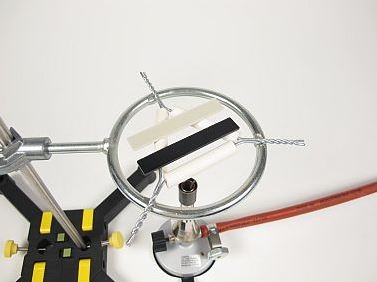Identification of plastics (1): thermoplastics and thermo-setting plastics Principle
Generally, plastics can be divided into two classes: thermoplastics and thermosets or duroplastics (and elastomers), which show a different behaviour due to their different molecular structures especially when heated. Because of the threadlike structure of thermoplastics (which can be "frozen" when heated and afterwards quenched), they show a "memory-effect" when re-heated and they take their original shape again. The behaviour of duroplastics and thermoplastics when heated is examined uin this experiment. Learning objectives - Detection methods for thermoplastics and duroplastics
Benefits - Easy teaching and efficient learning by using interactive experimentation PHYWE-Software
- Experiment is part of a complete solution set with experiments for the topic Chemistry of Polymers matched with international curriculum: all topics are covered
Scope of delivery |
Support base, variable
|
02001-00
|
1
| |
Stand rods, stainless steel, various sizes
|
02059-00
|
1
| |
Triangle w.pipeclay, l 50mm
|
33277-00
|
1
| |
Crucible tongs, 200 mm, stainless steel
|
33600-00
|
2
| |
Ring with boss head, i. d. = 10 cm
|
37701-01
|
1
| |
Protecting glasses, clear glass
|
39316-00
|
1
| |
Scissors, l = 110 mm, straight, point blunt
|
64616-00
|
1
| |
Beakers, Boro, low form, various sizes
|
46055-00
|
1
| |
Zinc, sheet 250x125x0.5 mm, 200 g
|
30245-20
|
1
| |
Sample set for study of plastics,
|
31730-07
|
1
| |
PVC-plates,pack.5 pcs.
|
31751-02
|
1
| |
PVC tubing, various inner diameters
|
39293-00
|
1
| |
Butane burner with cartridge, 220 g
|
32180-00
|
1
| |
Security bolster, 26,5 cm x 36,5 cm, aluminium
|
39180-01
|
1
|
|



